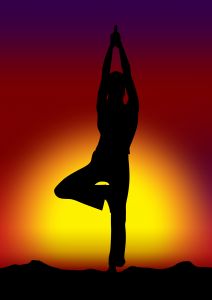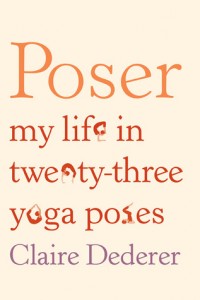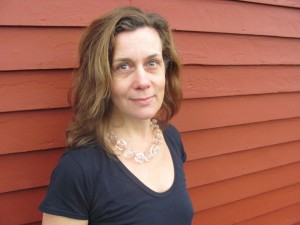Claire Dederer’s memoir, Poser: My Life in Twenty-Three Yoga Poses, published in January by Farrar, Straus and Giroux, is structured around her developing relationship with yoga and the insights she has gleaned from her practice. Her wry and sincere writing style elevates her book above the typical “yoga saved my life” story. Claire didn’t need saving, exactly, but yoga provided a window through which she came to a better understanding of herself and her life: her daily struggles to reconcile the roles of wife, mother, freelance writer and yogi, and, deeper in the past, events of her childhood that may have influenced her, especially her feminist mother’s decision to leave her father. Claire’s articles have appeared in the New York Times, Vogue, New York magazine, The Nation, Real Simple, Slate, Salon, and many other publications. She lives on an island near Seattle.
Poser explores your relationships and choices today, and your mother’s relationships and choices and how these affected you. It’s also about the influence of feminist ideals. And about yoga. Which of these first sparked your desire to write the memoir?
The idea really started with a piece I wrote many years ago for The Nation about Erica Jong. In it, I explored the notion of my mother’s generation, this group of women who had small children when the idea of personal freedom and liberation was taking hold. I became fascinated with this question — how do you pursue freedom with kids in tow? From there, I became interested in how we, the children of that generation, have reacted.
The memoir has a complex but flowing structure, moving from the present back into various pasts. How did you come up with the idea of 23 yoga poses as the unifying thread?
In 2007, my family and I were spending a year living on the top of a mountain in Colorado. One spring day we were snowed in, with huge drifts around the house, so I couldn’t get to yoga class. So I was doing poses at home. Doing my yoga alone really got me to thinking about what complicated emotions and thoughts I had about each pose. These feelings, once I thought about them, were almost hilariously rich and developed: I had a kind of love affair with headstand; I was in a gigantic argument with revolved triangle.
At that moment, I got the idea to edit an anthology of essays by different authors. Not yoga experts, but writers who are funny and good at parsing their experiences. Each author would write about a different pose. I told my husband, who is also a writer, and he immediately said, “Why don’t you just try writing the whole thing yourself?” The minute he said it, I was off and running. It was the perfect moment to be snowbound, with nothing but time on my hands.
For years I’d been thinking about motherhood, daughterhood, and the legacy of divorce and feminism. I wondered if the two seemingly separate themes — yoga and my generation’s very specific way of mothering — might work together. The writing really took off when I realized the yoga structure made a great way to explore feelings and thoughts I’d been having about motherhood.
Tell me about your writing background, and, specifically, what previous writing paved the way for Poser.
I started out as a film critic for Seattle Weekly. Once I began freelancing, I mostly wrote book reviews and other forms of cultural criticism for the New York Times, The Nation, Slate, and a bunch of other publications. I was on a (perhaps demented) quest to make a living as a freelance book reviewer. A doomed idea, but I gave it my best shot, and it was actually a good, structured way to keep writing while my kids were small and I was the primary caregiver.
After a decade or so of writing criticism, I grew weary of dissecting other people’s work. I wanted to take the risk of telling my own stories. So I began to weave memoir into my work — for instance, I would use memoir elements in my criticism. I also began to write personal essays and short memoir pieces that were published in Vogue and Real Simple, and also in a couple of anthologies. I knew right away that there was a lot of room to grow with my memoir voice, that it would support quite a bit of writing. And I began to look around for book-length nonfiction ideas. I wanted to take this new voice out for a long spin.
 You’ve said that when writing, your favourite part is the feeling you’re “solving a huge puzzle.” Was this memoir a much more difficult puzzle than a critical or personal essay, and did you follow the same basic process?
You’ve said that when writing, your favourite part is the feeling you’re “solving a huge puzzle.” Was this memoir a much more difficult puzzle than a critical or personal essay, and did you follow the same basic process?
This book was certainly a puzzle. The main challenge was to link the chapters into a narrative arc. Because I had some experience as an essayist, and because I wanted to explore each pose and its individual theme in each chapter, there was some concern that the final book would read like a series of disparate essays. I really struggled to find the story that finally emerged. I think this process — of turning a life into narrative — is the most difficult part of memoir.
Did you begin by creating an outline, and if so, how much did the final version resemble the outline?
I did start with an outline — and the final book is, in some ways, very similar to that outline. But I also deviated wildly and had many moments of wondering if I would ever find the book’s real shape. The most important thing I took from the outline were the starting and stopping points for the book. One of the strangest things about memoir is figuring out when the story really begins and when it ends. It’s surprisingly difficult — I think most memoirists would agree about this.
The number 23 has no special significance. It was just a matter of chapter length — I was very concerned with keeping the narrative moving, so I didn’t want to break it into too many chapters. It was fun to link the poses’ themes to the larger story — I could’ve happily written about 40 or 50 poses. But I think that would’ve impeded the narrative flow.
“Being written about in a memoir is officially no fun,” you write in your Acknowledgments. In Poser you candidly share thoughts about your relationship with your husband and his depression. How did he handle this?
My husband Bruce was entirely on board with what I wrote — he never asked me to cut anything. In terms of figuring out the right level of exposure for Bruce, we had a really fortunate thing happen while I was writing the book. Bruce has this friend, a writer named Dan Duane, and Dan’s wife, Elizabeth Weil, has been writing a memoir about their marriage over the last couple of years. It’s called No Cheating, No Dying, and it’ll come out this winter. Very private stuff, and very exposing of Dan. (And also very smart and riveting.) Elizabeth Weil published a chunk of the memoir in the New York Times Magazine during the period I was writing about my own marriage and struggling with how much to reveal about Bruce’s inner demons. Bruce read the article, tossed it across the breakfast table to me, and said, “I could live with that level of exposure.” It was very freeing and helpful to have a yardstick like that.
Incidentally, Bruce and I have heard from many people since the book was published, thanking us for telling his story frankly — it’s made me wonder if there’s a sort of quiet epidemic of new fathers dealing with depression.
What doubts, if any, did you face while writing such a personal story?
Oh my lord. Every day I faced every kind of doubt imaginable. My biggest doubt had to do with the very ordinariness of my story. There’s a question that hovers like a cloud over every memoirist: Who the hell cares? Who cares about my life? All you can do is learn to live with that cloud.
 How do you feel about comparisons between Poser and Elizabeth Gilbert’s Eat, Pray, Love?
How do you feel about comparisons between Poser and Elizabeth Gilbert’s Eat, Pray, Love?
The comparison is inevitable. Both of us, as narrators, were trying to live in a new way. Her character went on a trip; I stayed home. I guess that’s the most interesting contrast — my book asks: How we do change, if we’re stuck at home?
How much did you consider the skeptical reader as you crafted your memoir? I’ve been practising yoga myself only for a few months, and while I’m enjoying it — much more, even, than I’d expected to — I could relate to your initial questioning of Westerners adopting and adapting an Eastern philosophy and practice.
Certainly I kept the skeptical reader foremost in my mind as I wrote. If I had not done that, the entire project would’ve been sunk. I set out to write something about yoga that wasn’t mushy or New Age-y or blandly spiritual. The skeptical reader was always the most important reader to me.
Though your memoir has received much praise, some reviewers criticized passages where you move away from your personal story to discuss demographics and the broader social backdrop. How would you respond to this?
My main concern as a writer is with the reader’s experience, but at the same time there’s a sense in which we really need to write about and explore what we are passionately interested in. This demographic/social backdrop stuff was something I loved writing about, and it informed my point of view on all the other levels of the book as well. The writing might not be as lively and personal as some of the storytelling that happens in Poser, but at the same time, I think the social backdrop stuff gives resonance and heft to the story.
You’ve said that you often incorporate elements of personal essay into your critical writing. Can you elaborate?
I believe criticism is largely a subjective art. When I write a review, I don’t think I’m some kind of authoritative judge, handing down an opinion. And I tend not to like or read critics who write in that vein. I think giving the reader a glimpse into my own perspective is helpful. It helps us all remember that, even in my role as critic, I’m just a person, with my own prejudices and perspectives.
Now having written a long memoir, can you say whether you prefer short or long written forms? And do you see yourself writing another book-length memoir?
I’ve been a journalist for many years, and have written more than my fair share of short-form pieces. I’m very excited about the long form, and am working on another book-length personal narrative. I’m curious to see if it’s easier the second time around. I doubt it.
Claire Dederer’s Tips for Memoirists
 Say the thing you don’t want to say. There is some uncomfortable truth at the heart of your story. Make yourself write it. Tell yourself you’re not going to show it to anyone else. Just write it. That uncomfortable truth is where your story lives. If you can write it honestly, you’re committing an act of kindness for your reader. That’s the part of the book the reader will connect to most deeply — the part that will make the reader feel the relief of having someone articulate one of their darkest truths. The horrible truth also happens to be where a lot of humour resides.
Say the thing you don’t want to say. There is some uncomfortable truth at the heart of your story. Make yourself write it. Tell yourself you’re not going to show it to anyone else. Just write it. That uncomfortable truth is where your story lives. If you can write it honestly, you’re committing an act of kindness for your reader. That’s the part of the book the reader will connect to most deeply — the part that will make the reader feel the relief of having someone articulate one of their darkest truths. The horrible truth also happens to be where a lot of humour resides.
The essential story of every memoir is the transformation of the narrator. Students often mistake event for story. Event is not story. Our lives are filled with incredibly boring events — we can’t and shouldn’t include every event in our memoirs. We have to choose carefully what we write about. If we always keep in mind the essential story arc — the transformation of the narrator — then it starts to be easier to select the events we want to use. Each event must support that crucial, central arc.
Scene is king. Think of memoir as a body. It’s made of cells. And those cells are scenes. The memoir cannot exist in the general, in the abstract, in the hazy. It requires scenes. Scenes that are like status updates on your narrator. Scenes with sensation and dialogue and action …
* * *
Claire is my latest guest author for Memories into Story: Introduction to Life Writing, a 10-week online course offered by University of Toronto in partnership with the New York Times Knowledge Network.
Read also: “Why Americans Love Yoga,” by Claire Dederer, Slate, July 12, 2010. And visit Claire’s site at www.clairedederer.com

Claire’s insights into the level of comfort she agreed to disclose about her husband’s depression sounds like a reasonable collaboration between husband and wife. If the intent is not to harm, and there is trust on both sides, and sensitivity, you are a fortunate writer indeed.
Her tips at the end of the interview are well taken. Simple and instructive. Thanks again for introducing us to a memoir writer whose success at the craft loans important information to those of us making decisions about our own memoirs.